| ||
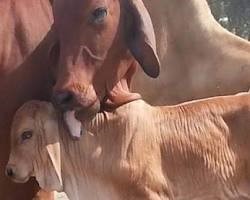 The Baherie cattle is a breed of cattle found on the coast of the Massawa region in eastern Eritrea. They have been called Bahari, meaning cattle from the sea/ocean, or Berbera, meaning cattle from Somalia or Aden of Yemen. These alternative names suggest recent origins of the cattle from the Arabian peninsula or Somalia. They are in the Somali Shorthorned zebu subgroup. They are small with short horns; coat color varies from fawn to reddish brown. They are used for their milk and their meat.
The Baherie cattle is a breed of cattle found on the coast of the Massawa region in eastern Eritrea. They have been called Bahari, meaning cattle from the sea/ocean, or Berbera, meaning cattle from Somalia or Aden of Yemen. These alternative names suggest recent origins of the cattle from the Arabian peninsula or Somalia. They are in the Somali Shorthorned zebu subgroup. They are small with short horns; coat color varies from fawn to reddish brown. They are used for their milk and their meat.
| ||
 | ||
| ||
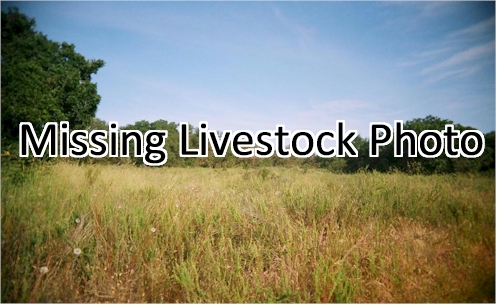 Bakosi cattle, also known as Bakuri or Kosi, are a Savannah Shorthorn breed of cattle in Cameroon maintained by the ethnic group Bakossi. They are found in the south-western mountains of Cameroon, west of the Nkongsamba on the border between the Southwest region and Littoral provinces. They are used for their meat, hides, payment of bride price and rituals. Their coats vary from black to white but more than half are brown or black. Their calving interval is between 18 and 24 months.
Bakosi cattle, also known as Bakuri or Kosi, are a Savannah Shorthorn breed of cattle in Cameroon maintained by the ethnic group Bakossi. They are found in the south-western mountains of Cameroon, west of the Nkongsamba on the border between the Southwest region and Littoral provinces. They are used for their meat, hides, payment of bride price and rituals. Their coats vary from black to white but more than half are brown or black. Their calving interval is between 18 and 24 months.
| ||
 | ||
| ||
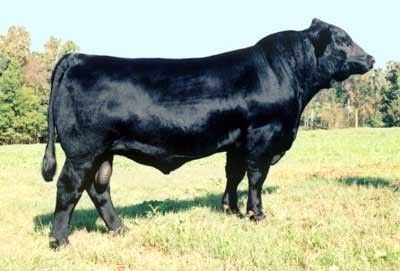 Balancer cattle were developed by crossing a purebred
Gelbvieh with a purebred Angus. This 50% Gelbvieh / 50% Angus cross combine
Gelbvieh''s growth, muscle and leanness with Angus''s calving ease, moderate size
and marbling.
Balancer cattle were developed by crossing a purebred
Gelbvieh with a purebred Angus. This 50% Gelbvieh / 50% Angus cross combine
Gelbvieh''s growth, muscle and leanness with Angus''s calving ease, moderate size
and marbling.
Balancers offer the consistency of their parents combined with the hybrid vigor of a crossbred. They are registered with documented parentage and EPD''s. | ||
 | ||
| ||
 Bale cattle are recognized for their distinctive appearance, characterized by a medium to large frame, muscular build, and a deep, well-rounded body. They typically possess short, glossy coats that range in color from various shades of red to deep brown or black. Additionally, Bale cattle are known for their long, lyre-shaped horns, which curve outward and upward, adding to their striking visual appeal.
Bale cattle are recognized for their distinctive appearance, characterized by a medium to large frame, muscular build, and a deep, well-rounded body. They typically possess short, glossy coats that range in color from various shades of red to deep brown or black. Additionally, Bale cattle are known for their long, lyre-shaped horns, which curve outward and upward, adding to their striking visual appeal.Renowned for their versatility, Bale cattle serve multiple purposes in the agricultural landscape of the region. They are primarily raised for their high-quality meat, which is prized for its tenderness, flavor, and nutritional value. Additionally, Bale cattle are valued for their ability to provide milk and serve as reliable draf ... | ||
 | ||
| ||
 Baoule cattle (also known as Lobi or Mere cattle) are a breed of Savannah Shorthorn cattle found in north and central Ivory Coast and the southern tip of Mali. They are found in pure form in Bouaké, Bouna, and Dabakala. They are mostly kept by Fula herdsmen.
Baoule cattle (also known as Lobi or Mere cattle) are a breed of Savannah Shorthorn cattle found in north and central Ivory Coast and the southern tip of Mali. They are found in pure form in Bouaké, Bouna, and Dabakala. They are mostly kept by Fula herdsmen.
They are dwarf animals with cows being 90–100 cm, and bulls being 100–110 cm. They have a massive head and short, stout horns with a short neck that is thin in cows and heavy in bulls. Their bodies are well-rounded with a straight back-line. The tail-head is high and thick, and their coat color varies from mostly black to black pied. They produce 120–390 kg of milk in a lactation period lasting 280–340 days. The dressing percentage of a Baoule carcass is 50%. | ||
 | ||
| ||
 Barrosã cattle are native to Portugal. They are known mainly for their big distinctive horns, which can grow well over 100 cm in length.
Barrosã cattle are native to Portugal. They are known mainly for their big distinctive horns, which can grow well over 100 cm in length. During the beginning of the 20th century, Barrosã cattle were numerous, registering more than 200,000 animals. But due to the industrial revolution, the appearance of machines and commercial breeds (more productive for meat and milk production), the animal became more and more rare, until 2005, when there were only about 7,000 left. The meat of Barrosã Cattle has a very appealing red blood color, giving the cuts of meat a slightly wet and marbled aspect. The combination of the genetic characteristics associated with an exclusive feeding plan based on maternal milk, foraging and grain all ... | ||
 | ||
| ||
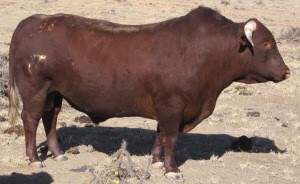 Barzona cattle development began in 1942 when F.N. Bard, an
Arizona rancher, decided to develop a breed that would be adapted to their
rugged, dry, and rocky terrain. He used Hereford, Angus, Afrikander, and Santa
Gertirudis cattle in more or less equal parts. Production records were
maintained and a rigid selection was carried out for fertility, rate of gain,
and mothering ability.
Barzona cattle development began in 1942 when F.N. Bard, an
Arizona rancher, decided to develop a breed that would be adapted to their
rugged, dry, and rocky terrain. He used Hereford, Angus, Afrikander, and Santa
Gertirudis cattle in more or less equal parts. Production records were
maintained and a rigid selection was carried out for fertility, rate of gain,
and mothering ability.
Only the most desirable animals were retained for the breeding program. Selection was made for hardiness traits that include good feet and legs and the ability cover rough ground and graze sparse ranges and survive in simi-desert conditions. Modern Barzona are a hardy medium size beef animal, distinguished a longish horned or polled h ... | ||
 | ||
| ||
 Batangas Cattle is a breed of cattle that is native to the province of Batangas in the Philippines. They are known for their hardiness, adaptability, and resistance to disease. They are medium-sized animals, with a distinctive dark brown color. They have long, curved horns and a hump on their shoulders. They are known for their high milk production and good milk quality. They are also used as draught animals and for meat production.
Batangas Cattle is a breed of cattle that is native to the province of Batangas in the Philippines. They are known for their hardiness, adaptability, and resistance to disease. They are medium-sized animals, with a distinctive dark brown color. They have long, curved horns and a hump on their shoulders. They are known for their high milk production and good milk quality. They are also used as draught animals and for meat production.
They are considered as a hardy breed and well-suited for extensive farming. The breed is considered endangered, and conservation efforts are being made to preserve the breed. They are well-suited for the hot and humid climate of the Philippines. The breed is believed to have originated from ... | ||
 | ||
| ||
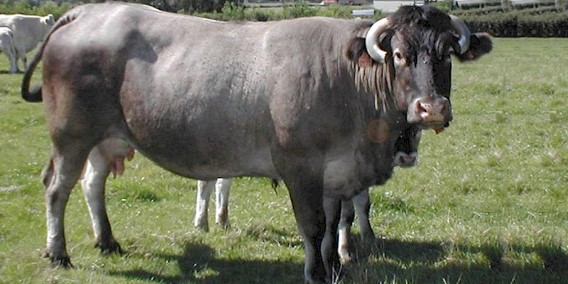 Bazadaise (also called Bazadais) are French cattle raised
primarily for meat production. They originated in the low-laying areas to the
south of the River Garonne near that town. But they get their name from the
town of Bazas in the department of the Gironde, in the Nouvelle-Aquitaine
region of south-western France.
Bazadaise (also called Bazadais) are French cattle raised
primarily for meat production. They originated in the low-laying areas to the
south of the River Garonne near that town. But they get their name from the
town of Bazas in the department of the Gironde, in the Nouvelle-Aquitaine
region of south-western France. It is believed that they may be the result of the inter-breeding of local cattle breeds of Aquitaine cattle with other local breeds. They were previously used as a draught animal. A festival is held each year named the Fete des Boeufs Gras for presenting the fattened Bazadaise stock and their meat. Their meat is heavily marbled and renowned for its tenderness and flavor. Their total numbers was n ... | ||
 | ||
| ||
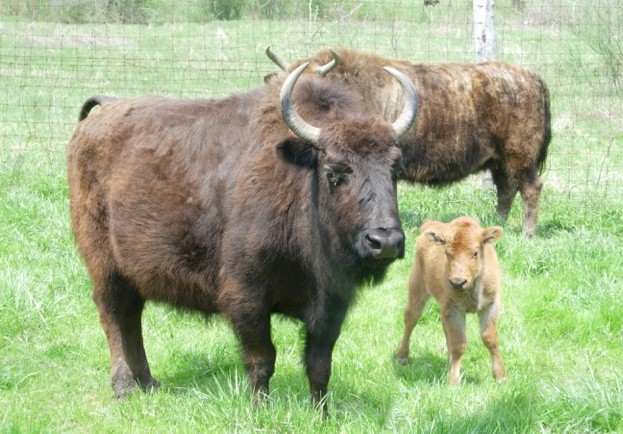 Beefalo, also referred to as cattalo, are a fertile hybrid offspring of domestic cattle and the American bison. They were created to combine the characteristics of both animals for beef production. Beefalo are primarily cattle in genetics and appearance, with the breed association defining a full Beefalo as one with three-eighths bison genetics, while animals with higher percentages of bison genetics are called "bison hybrids".
Beefalo, also referred to as cattalo, are a fertile hybrid offspring of domestic cattle and the American bison. They were created to combine the characteristics of both animals for beef production. Beefalo are primarily cattle in genetics and appearance, with the breed association defining a full Beefalo as one with three-eighths bison genetics, while animals with higher percentages of bison genetics are called "bison hybrids".Beefalo are primarily bred in the United States and Australia, though countries like New Zealand, Brazil, and South Africa also have small herds. There is a rising demand from consumers, so more producers are needed to meet this increasing demand. Breeding bison and cattle is not something new, but ... | ||
 | ||
| ||
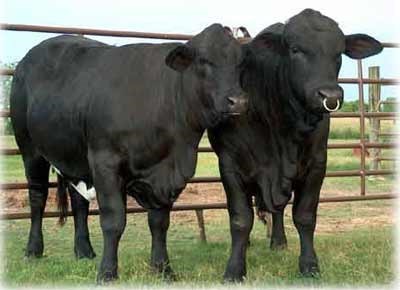 Beefmaker cattle were developed by the Wright family beginning in 1972 on the NSW properties Wallamumbi and Jeogla. The breeding is based on a specially designed genetic program which involves infusing Simmental blood with specially-selected base Herefords.
Beefmaker cattle were developed by the Wright family beginning in 1972 on the NSW properties Wallamumbi and Jeogla. The breeding is based on a specially designed genetic program which involves infusing Simmental blood with specially-selected base Herefords.
The Beefmaker program was designed to produce an animal with faster growth rates, heavier carcass weights, an improved ratio of lean carcass meat to fat, maximum fertility, improved lactation, and greater stress tolerance compared to the two contributing base breeds. After eight generations the Beefmaker has been stabilized at 75 percent Hereford and 25 percent Simmental content. It has established a national reputation for high conversion efficiency levels, high ... | ||
 | ||
| ||
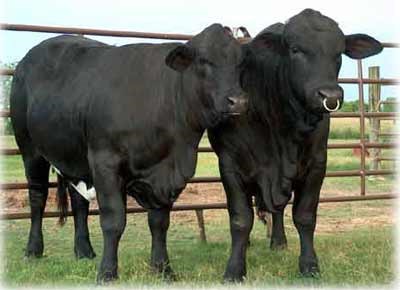 Beefmaster cattle were
developed in the early 1930s by Tom Lasater. He crossed Hereford, Shorthorn and
Brahman cattle. The exact mixture of the foundation cattle is not known, but it
is thought to be about 25% Hereford, 25% Shorthorn, and 50% Brahman. Lasater''s
purpose was to develop cattle that would be more productive than existing
breeds in the harsh environment of South Texas. The cattle were heavily
selected on what has become known as the Six Essentials - Weight, Conformation,
Milking Ability, Fertility, Hardiness and Disposition.
Beefmaster cattle were
developed in the early 1930s by Tom Lasater. He crossed Hereford, Shorthorn and
Brahman cattle. The exact mixture of the foundation cattle is not known, but it
is thought to be about 25% Hereford, 25% Shorthorn, and 50% Brahman. Lasater''s
purpose was to develop cattle that would be more productive than existing
breeds in the harsh environment of South Texas. The cattle were heavily
selected on what has become known as the Six Essentials - Weight, Conformation,
Milking Ability, Fertility, Hardiness and Disposition.No selection was made for characteristics that do not affect the carcass, such as horns, hide or color. These Six Essentials became the economic strength of Beefmasters and have made th ... | ||
 | ||
| ||
 Belgian Blue cattle are medium-sized, heavy cattle,
sometimes with a massive double muscle structure. Their colors are blue, white,
and blue and white. Belgian Blues are small boned with a sloping rump, hidden
hips, strong legs and a relatively small head. They are quite robust and
healthy.
Belgian Blue cattle are medium-sized, heavy cattle,
sometimes with a massive double muscle structure. Their colors are blue, white,
and blue and white. Belgian Blues are small boned with a sloping rump, hidden
hips, strong legs and a relatively small head. They are quite robust and
healthy.Belgian Blues produce a cross bred steer with a high yielding carcass dressing out between 65 and 70 per cent. The meat is tender with a minimum coverage of fat with a high proportion of the valuable cuts. The proportion of difficult births is particularly high among heifers. | ||
 | ||
| ||
 The Belgian Red cattle are a multipurpose (both milk and meat production) breed of cattle developed in the West Flanders region of Belgium. They are also known as Red Flemish, West Flemish, West Flemish Red, Rood ras van België (Flemish) and Rouge de Belgique (French) cattle.
The Belgian Red cattle are a multipurpose (both milk and meat production) breed of cattle developed in the West Flanders region of Belgium. They are also known as Red Flemish, West Flemish, West Flemish Red, Rood ras van België (Flemish) and Rouge de Belgique (French) cattle.
They were developed from Cassel and Veurne-Ambacht cattle. Currently they are found throughout West Flanders and they constitute about 7 percent of the Belgian national herd. Belgian Red cattle are generally long, heavy and large animals. They are primarily solid red in color with potentially a few white patches on head, underline, dewlap and legs and also on udder or scrotum. Both bulls and cows usually have horns. They are a medium-sized breed, ... | ||
 | ||
| ||
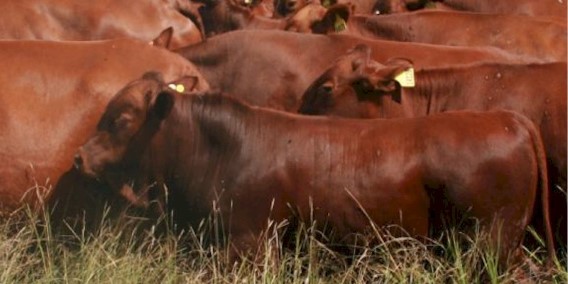 Belmont Red are Australian cattle raised mainly for meat
production. They were developed by the CSIRO (Commonwealth Scientific and
Industrial Research Organization) during 1954 in response to the need in the
Australian Tropics for cattle which would improve the fertility of Bos indicus
cattle. And it was released to the Australian cattle breeders by the CSIRO in
1969. They were developed from several Bos Taurus cattle breeds including
Africander (African Sanga), Hereford, and Shorthorn. The breed has exhibited
higher fertility than pure Bos indicus cattle breeds and better than most other
Bos taurus and Bos indicus cross. Along with improved fertility the breed also
remain the characteristics of hardiness and heat and tick toleranc
...
Belmont Red are Australian cattle raised mainly for meat
production. They were developed by the CSIRO (Commonwealth Scientific and
Industrial Research Organization) during 1954 in response to the need in the
Australian Tropics for cattle which would improve the fertility of Bos indicus
cattle. And it was released to the Australian cattle breeders by the CSIRO in
1969. They were developed from several Bos Taurus cattle breeds including
Africander (African Sanga), Hereford, and Shorthorn. The breed has exhibited
higher fertility than pure Bos indicus cattle breeds and better than most other
Bos taurus and Bos indicus cross. Along with improved fertility the breed also
remain the characteristics of hardiness and heat and tick toleranc
...
| ||
 | ||
| ||
.jpg) Belted Galloway cattle originate from Galloway, Scotland and are most recognizable by their hairy coats with a white belt that completely circles their bodies across their mid sections. They are nicknamed “Oreo Cows”, “Panda Cows” or “Belties.” They are primarily black and white, but dun and red belted Galloways are also recognized by breed societies.
Belted Galloway cattle originate from Galloway, Scotland and are most recognizable by their hairy coats with a white belt that completely circles their bodies across their mid sections. They are nicknamed “Oreo Cows”, “Panda Cows” or “Belties.” They are primarily black and white, but dun and red belted Galloways are also recognized by breed societies.
Belted Galloways are a heritage breed of cattle and date back to the early 1800''s. The exact origin of the white belt across their belly is unknown, but it is thought to have come from crossbreeding with Dutch Belted cattle. Belted Galloways are raised for their high quality beef that typically has a marbled appearance. This means that it contains various amounts of in ... | ||
 | ||
| ||
 Bernese cattle, also known as "Berner Sennenhund" or "Bernese Mountain Dog Cattle," is a breed of dairy cattle that originated in the Bern region of Switzerland. They are known for their distinctive black and white coloration, with a black head, white blaze on the face, and black and white markings on the legs and body. They are a medium-sized breed, with cows typically weighing around 1,200-1,400 pounds and bulls weighing around 1,600-1,800 pounds. They are known for their good milk production and milk quality, with high butterfat and protein content. They are hardy and adaptable to different farming conditions and climates. They are also known for their docile temperament and good fertility.
Bernese cattle, also known as "Berner Sennenhund" or "Bernese Mountain Dog Cattle," is a breed of dairy cattle that originated in the Bern region of Switzerland. They are known for their distinctive black and white coloration, with a black head, white blaze on the face, and black and white markings on the legs and body. They are a medium-sized breed, with cows typically weighing around 1,200-1,400 pounds and bulls weighing around 1,600-1,800 pounds. They are known for their good milk production and milk quality, with high butterfat and protein content. They are hardy and adaptable to different farming conditions and climates. They are also known for their docile temperament and good fertility.
| ||
 | ||
| ||
 Berrendas cattle ( also known as Berrendas andaluza or Berrenda espanolas) are a rare breed used as guide animals for fighting bulls. There are two varieties, the Red Berrendas (Berrenda roja andaluza) and the Black Berrendas (Berrendas negra andaluza).
Berrendas cattle ( also known as Berrendas andaluza or Berrenda espanolas) are a rare breed used as guide animals for fighting bulls. There are two varieties, the Red Berrendas (Berrenda roja andaluza) and the Black Berrendas (Berrendas negra andaluza).
The conformation of the breed is similar to the Analusian or Retina breed, which are closely related. | ||
 | ||
| ||
 Betizu cattle are small mountain cattle which live in a semi-feral state in some mountainous parts of the Basque Country in both Basque Country and France. It is classified as an endangered breed by both the Ministerio de Agricultura, Pesca y Alimentación, the agriculture ministry of Spain, and by the Conservatoire des Races d''Aquitaine in France.
Betizu cattle are small mountain cattle which live in a semi-feral state in some mountainous parts of the Basque Country in both Basque Country and France. It is classified as an endangered breed by both the Ministerio de Agricultura, Pesca y Alimentación, the agriculture ministry of Spain, and by the Conservatoire des Races d''Aquitaine in France.The origins of Betizu cattle are unknown. The name betizu derives from the Basque: behi izua, "elusive cow", and distinguishes it from the extebehi or "house cow". It appears in Basque mythology as Zezengorri ("red bull"), guardian of the treasure of the goddess Mari. In 2013 the breed population in Navarra was estimated at 254, while the number in Aquitaine was put at less than ... | ||
 | ||
| ||
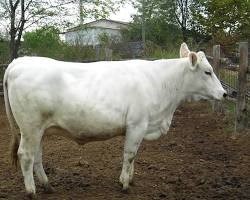 Bianca Val Padana is a breed of cattle that originated in the Po Valley region of Italy. They are known for their distinctive white color and are well-suited to the humid and hot conditions of the region. They are a medium-sized breed, with cows typically weighing around 1,200-1,400 pounds and bulls weighing around 1,600-1,800 pounds. They are known for their high milk production and good milk quality, with a high butterfat and protein content. They are also known for their docile temperament and good fertility. They are well-suited to intensive dairy farming systems, and are used primarily for milk production. They are considered to be a hardy and adaptable breed, which is well-suited to a variety of farming conditions.
Bianca Val Padana is a breed of cattle that originated in the Po Valley region of Italy. They are known for their distinctive white color and are well-suited to the humid and hot conditions of the region. They are a medium-sized breed, with cows typically weighing around 1,200-1,400 pounds and bulls weighing around 1,600-1,800 pounds. They are known for their high milk production and good milk quality, with a high butterfat and protein content. They are also known for their docile temperament and good fertility. They are well-suited to intensive dairy farming systems, and are used primarily for milk production. They are considered to be a hardy and adaptable breed, which is well-suited to a variety of farming conditions.
| ||
 | ||
| ||
.jpg) Blaarkop (also known as Groninger Blaarkop or Gronings
Blaarkop, Groninger, Groningue, Roodblaar, Roodwitkop, Zwartblaar, and
Zwartwitkop) are dairy cattle from the Netherlands. They are mainly found in
the Groningen province of Netherlands. They are an old breed which has been
mentioned as early as the 14th century. Their ancestry may be traced to the
Middle Ages.
Blaarkop (also known as Groninger Blaarkop or Gronings
Blaarkop, Groninger, Groningue, Roodblaar, Roodwitkop, Zwartblaar, and
Zwartwitkop) are dairy cattle from the Netherlands. They are mainly found in
the Groningen province of Netherlands. They are an old breed which has been
mentioned as early as the 14th century. Their ancestry may be traced to the
Middle Ages.
Blaarkop cattle are medium-sized typically with black color with a white head and belly. Although about 5 percent of the total population are red in color rather than black. The breed is sturdily built with matching muscles, a horned head and have very strong legs. There are black ring (blister) around their eyes, and the tail has a white tip. Both bulls ... | ||
 | ||
| ||
 Black Baldy cattle were developed by crossing Hereford cattle with a solid black breed, typically Aberdeen Angus. Additionally, Angus bulls are used on Hereford heifers to develop relatively small calves and mitigate dystocia. The term Black Baldy is mainly used in Australia and New Zealand. The term ''Black Whiteface'' is often used in certain areas in North America.
Black Baldy cattle were developed by crossing Hereford cattle with a solid black breed, typically Aberdeen Angus. Additionally, Angus bulls are used on Hereford heifers to develop relatively small calves and mitigate dystocia. The term Black Baldy is mainly used in Australia and New Zealand. The term ''Black Whiteface'' is often used in certain areas in North America.They have a white face like a Hereford, but the red body color of a Hereford is substituted by black from an Angus. The reason is that both the white face alleles and the black coat color in the cattle are genetically dominant. Black Baldy cows are known for being excellent mothers. In relation to the general hybrid vigor anticipated of a crossbred, the cross ... | ||
 | ||
| ||
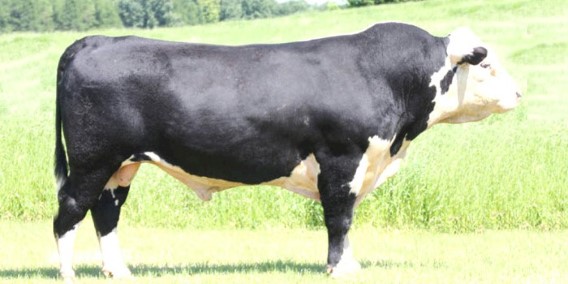 Black Hereford are beef cattle originally derived from the
Hereford cattle, but with some mixture from black Angus cattle. John Gage established
the American Black Hereford Association as a non-profit corporation in 1994.
And in 1997, the first Black Herefords to qualify for registration were
recorded. And the breed received international breed designation in 2003 by the
National Association of Animal Breeds. The association implemented it’s own
Expected Progeny Difference (EPD) ratios for individual animals by 2005. These
EPD ratios help producers for using performance data collected from each animal
and its offspring to accurately predict the performance of future offspring.
The American Black Hereford Association is experiencing
...
Black Hereford are beef cattle originally derived from the
Hereford cattle, but with some mixture from black Angus cattle. John Gage established
the American Black Hereford Association as a non-profit corporation in 1994.
And in 1997, the first Black Herefords to qualify for registration were
recorded. And the breed received international breed designation in 2003 by the
National Association of Animal Breeds. The association implemented it’s own
Expected Progeny Difference (EPD) ratios for individual animals by 2005. These
EPD ratios help producers for using performance data collected from each animal
and its offspring to accurately predict the performance of future offspring.
The American Black Hereford Association is experiencing
...
| ||
 | ||
| ||
 Black Pied dairy cattle is a breed of dairy cattle that is characterized by its black and white coloration. They are also known as "Holstein-Friesian" or "Friesian" cattle. They are one of the most common and widespread dairy cattle breeds in the world, known for their high milk production and good milk quality. They have a docile temperament, are hardy and adaptable to different farming conditions. They are alarge-sized breed, with cows typically weighing around 1,400-1,800 pounds and bulls weighing around 2,000-2,500 pounds. They are known for their high milk yield with an average of 22,000-25,000 pounds of milk per year and have a good protein and fat content. They are used primarily for milk production and are considered to be a hardy a
...
Black Pied dairy cattle is a breed of dairy cattle that is characterized by its black and white coloration. They are also known as "Holstein-Friesian" or "Friesian" cattle. They are one of the most common and widespread dairy cattle breeds in the world, known for their high milk production and good milk quality. They have a docile temperament, are hardy and adaptable to different farming conditions. They are alarge-sized breed, with cows typically weighing around 1,400-1,800 pounds and bulls weighing around 2,000-2,500 pounds. They are known for their high milk yield with an average of 22,000-25,000 pounds of milk per year and have a good protein and fat content. They are used primarily for milk production and are considered to be a hardy a
...
| ||
 | ||
| ||
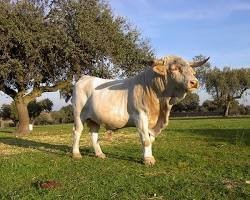 In the sun-drenched lands of Spain''s Caceres region, amidst rolling hills and golden plains, the Blanca Cacerena breed of cattle reigns supreme. Distinguished by their lustrous white coats that shimmer under the Iberian sun, these majestic beasts are as emblematic of the region''s landscape as the ancient olive groves and rugged mountains that define it.
In the sun-drenched lands of Spain''s Caceres region, amidst rolling hills and golden plains, the Blanca Cacerena breed of cattle reigns supreme. Distinguished by their lustrous white coats that shimmer under the Iberian sun, these majestic beasts are as emblematic of the region''s landscape as the ancient olive groves and rugged mountains that define it.
Bred and honed by generations of local farmers, Blanca Cacerena cattle are renowned for their adaptability to the arid and sweltering conditions that characterize the region. Their medium-sized stature belies their formidable presence, with cows weighing in at a robust 600-800 kg and bulls towering at 800-1000 kg. Yet, it is not just their size that sets them apart, but their re ... | ||
 | ||
| ||
 Blanco Orejinegro BEW (Black Ear White) is a breed of cattle that originated in Spain. They are known for their distinctive white color with black ears. They are a medium-sized breed, with cows typically weighing around 600-800 kg and bulls weighing around 800-1000 kg. They are known for their good milk production, with an average of 4,200 - 5,500 kg of milk per lactation, and good milk quality, with high protein and butterfat content. They are also known for their docile temperament and good fertility. They are known for their hardiness and ability to adapt to different farming conditions and climates. They are well-suited for grazing in rangelands and considered to be a hardy and adaptable breed. They are primarily used for milk productio
...
Blanco Orejinegro BEW (Black Ear White) is a breed of cattle that originated in Spain. They are known for their distinctive white color with black ears. They are a medium-sized breed, with cows typically weighing around 600-800 kg and bulls weighing around 800-1000 kg. They are known for their good milk production, with an average of 4,200 - 5,500 kg of milk per lactation, and good milk quality, with high protein and butterfat content. They are also known for their docile temperament and good fertility. They are known for their hardiness and ability to adapt to different farming conditions and climates. They are well-suited for grazing in rangelands and considered to be a hardy and adaptable breed. They are primarily used for milk productio
...
| ||
 | ||
| ||
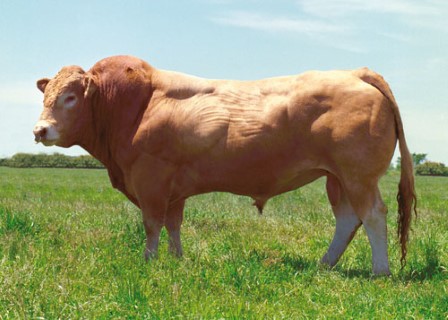 Blonde d''Aquitaine cattle originated in the Garonne valleyrnand the Pyrenees mountains in the Aquitaine district of France.
Blonde d''Aquitaine cattle originated in the Garonne valleyrnand the Pyrenees mountains in the Aquitaine district of France. Blondes'' short smooth hair is usually wheat colored, but canrnrange from almost white to brown. They are known for their lean muscling, highrngrowth rate, docility and calving ease due to a high tail setting, large pelvicrnarea and light bone. The average weight of mature females is 1600-1900 poundsrnand bulls 2500-2800 pounds. These are big blondes! They are the third largest breed in France after thernLimousin and Charolais cattle. They were first imported into the United Statesrnin 1972. | ||
 | ||
| ||
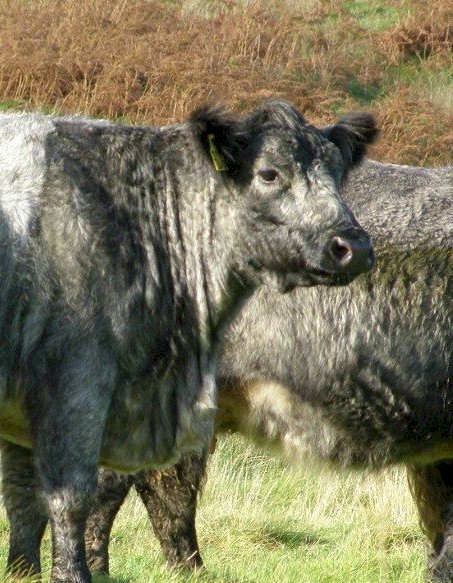 Blue Grey cattle hybrid traditionally from south-western Scotland and north-western England. They result from breeding a black Galloway cow to a white Shorthorn bull.
Blue Grey cattle hybrid traditionally from south-western Scotland and north-western England. They result from breeding a black Galloway cow to a white Shorthorn bull.
In south-western Scotland and north-western England, Shorthorn bulls were used from the early nineteenth century on black Galloway cows to produce vigorous hybrid calves. If the bull was white, the calf was blue roan in color; these were easily recognizable and were much in demand. In the later nineteenth century, selection of the White bred Shorthorn was begun specifically to supply white sires for production of these calves.? Blue Grey cattle are blue roan in color, and are polled (without horns). Cows have high amounts of body fat compared to other hybrids in s ... | ||
 | ||
| ||
 Bohus Polled cattle is a breed of cattle that originated in the Bohuslän region of Sweden. They are known for their distinctive polled gene, meaning they do not have horns, which is a genetic trait. They are a medium-sized breed, with cows typically weighing around 600-800 kg and bulls weighing around 800-1000 kg. They are known for their good milk production, with an average of 4,200 - 5,500 kg of milk per lactation, and good milk quality, with high protein and butterfat content. They are also known for their docile temperament and good fertility. They are known for their hardiness and ability to adapt to different farming conditions and climates. They are well-suited for grazing in rangelands and considered to be a hardy and adaptable bre
...
Bohus Polled cattle is a breed of cattle that originated in the Bohuslän region of Sweden. They are known for their distinctive polled gene, meaning they do not have horns, which is a genetic trait. They are a medium-sized breed, with cows typically weighing around 600-800 kg and bulls weighing around 800-1000 kg. They are known for their good milk production, with an average of 4,200 - 5,500 kg of milk per lactation, and good milk quality, with high protein and butterfat content. They are also known for their docile temperament and good fertility. They are known for their hardiness and ability to adapt to different farming conditions and climates. They are well-suited for grazing in rangelands and considered to be a hardy and adaptable bre
...
| ||
 | ||
| ||
 Bonsmara cattle is a breed of cattle that originated in South Africa. It is a composite breed, created by crossing Boran, Afrikaner, and Shorthorn cattle. The breed was developed to improve the performance of beef cattle in the harsh, semi-arid conditions of South Africa. They are a medium-sized breed, with cows typically weighing around 600-800 kg and bulls weighing around 800-1000 kg. They are known for their good growth rate, hardiness and adaptability to different farming conditions. They have a good resistance to diseases and are well-suited for grazing in rangelands. They have a high fertility rate and good mothering ability. They are primarily used for meat production, but also have good milk production with an average of 4,200 - 5,5
...
Bonsmara cattle is a breed of cattle that originated in South Africa. It is a composite breed, created by crossing Boran, Afrikaner, and Shorthorn cattle. The breed was developed to improve the performance of beef cattle in the harsh, semi-arid conditions of South Africa. They are a medium-sized breed, with cows typically weighing around 600-800 kg and bulls weighing around 800-1000 kg. They are known for their good growth rate, hardiness and adaptability to different farming conditions. They have a good resistance to diseases and are well-suited for grazing in rangelands. They have a high fertility rate and good mothering ability. They are primarily used for meat production, but also have good milk production with an average of 4,200 - 5,5
...
| ||
 | ||
| ||
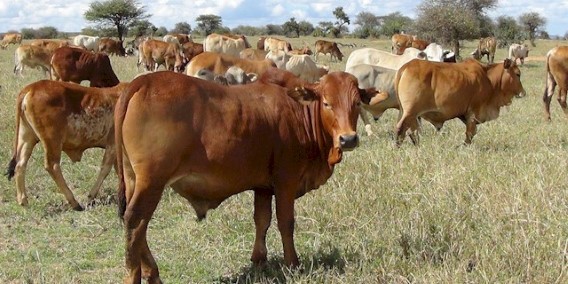 Boran are beef cattle. They are a Zebu breed which was
developed from the native shorthorned Zebu cattle of the Borana people of the
southern Ethiopia. They are usually white or fawn with the bulls being darker
with black points. They have many similarities to American Brahman cattle and
they are descended from cattle from the western coast of India. Kenyan ranchers
developed the Boran cattle and they are found in northern Kenya, southern
Ethiopia, and southwestern Somalia.
Boran are beef cattle. They are a Zebu breed which was
developed from the native shorthorned Zebu cattle of the Borana people of the
southern Ethiopia. They are usually white or fawn with the bulls being darker
with black points. They have many similarities to American Brahman cattle and
they are descended from cattle from the western coast of India. Kenyan ranchers
developed the Boran cattle and they are found in northern Kenya, southern
Ethiopia, and southwestern Somalia. They were imported to Australia in 1990. The Boran Cattle Breeder’s Society has been managed since 1951 and strategically breed these animal in Kenya. There were approximately 454 beef ranches in Kenya as of 2008. They are a small to medi ... | ||
 | ||
| ||
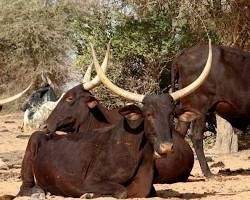
Bororo cattle, also known as Gudali or Guraphe, are a distinct breed of cattle primarily found in West Africa, particularly in countries like Nigeria, Cameroon, Chad, and Niger. Renowned for their adaptability to harsh environmental conditions and their vital role in the livelihoods of local communities, Guraphe cattle exhibit unique characteristics that make them invaluable assets in various agricultural settings. Physical CharacteristicsGuraphe cattle are typically medium to large in size, with bulls weighing between 400 to 600 kilograms (880 to 1320 pounds) and cows ranging from 300 to 450 kilograms (660 to 990 pounds). They possess a robust frame, characterized by strong bones and well-developed musculature, whic
...
| ||
 | ||
| ||
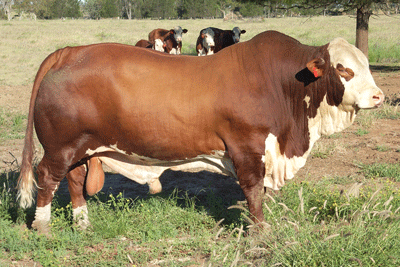 Braford cattle were developed by Alto Adams Jr. on his
Florida ranch in 1947. He began experimenting with various types of
Brahman-Hereford cross bulls. Eventually he identified Braford bulls that were
producing calves that met his needs and he used these bulls and their offspring
to form what is recognized as the Foundation Herd of the Braford breed in the
United States.
Braford cattle were developed by Alto Adams Jr. on his
Florida ranch in 1947. He began experimenting with various types of
Brahman-Hereford cross bulls. Eventually he identified Braford bulls that were
producing calves that met his needs and he used these bulls and their offspring
to form what is recognized as the Foundation Herd of the Braford breed in the
United States.
Brafords are known for superior maternal ability. Early puberty, fertility, calving ease, optimum milk production, maternal aptitude and productive longevity have earned Brafords this distinguished reputation. Brafords consistently and efficiently produce a uniform product in specific production environments. Most often they have a ... | ||
 | ||
| ||
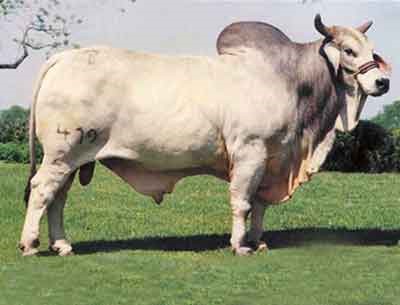 Brahman cattle originated from Bos Indicus cattle originally
brought from India. Through centuries of exposure to inadequate food supplies,
insect pests, parasites, diseases and the weather extremes of tropical India,
the native cattle developed some remarkable adaptations for survival.
Brahman cattle originated from Bos Indicus cattle originally
brought from India. Through centuries of exposure to inadequate food supplies,
insect pests, parasites, diseases and the weather extremes of tropical India,
the native cattle developed some remarkable adaptations for survival.Brahman cattle are easily identified by the hump on their back and long floppy ears. Their most common colors are solid gray or solid red. They have loose saggy skin with sweat glands and the ability to sweat freely through the pores of the skin, which contributes materially to their heat tolerance. They can walk long distances to water and they thrive where other types of cattle, at best, merely survive. Brahman cattle are ... | ||
 | ||
| ||
 Brahmousin breed blends the best of Limousin and Brahman characteristics. Purebred Brahmousin are classified as five-eights (5/8) Limousin and three-eights (3/8) Brahman. This mix has been found to be the most widely accepted and most useful for the majority of the United States. However, the American Brahmousin Council offers a flexible program that allows animals that are not purebred to be recorded as long as they are at least one-quarter (1/4) Limousin and one-quarter (1/4) Brahman. It is important to note, that in order to be recorded as a Brahmousin, the animal must be sired by a registered Limousin bull, registered Brahman bull or a registered Brahmousin bull.
Brahmousin breed blends the best of Limousin and Brahman characteristics. Purebred Brahmousin are classified as five-eights (5/8) Limousin and three-eights (3/8) Brahman. This mix has been found to be the most widely accepted and most useful for the majority of the United States. However, the American Brahmousin Council offers a flexible program that allows animals that are not purebred to be recorded as long as they are at least one-quarter (1/4) Limousin and one-quarter (1/4) Brahman. It is important to note, that in order to be recorded as a Brahmousin, the animal must be sired by a registered Limousin bull, registered Brahman bull or a registered Brahmousin bull.
Brahmousin cattle have a high heat tolerance, and are resistant ... | ||
 | ||
| ||
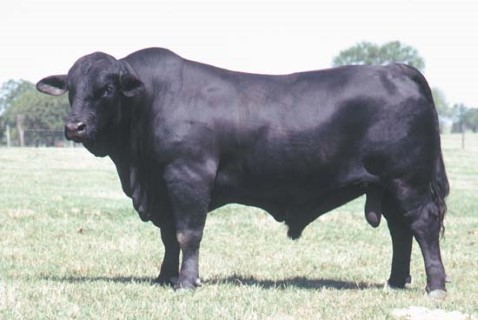 Brangus cattle were developed to utilize the superior traits
of Angus and Brahman cattle. Their genetics are stabilized at 3/8 Brahman and
5/8 Angus. The combination results in a breed which unites the traits of two
highly successful parent breeds.
Brangus cattle were developed to utilize the superior traits
of Angus and Brahman cattle. Their genetics are stabilized at 3/8 Brahman and
5/8 Angus. The combination results in a breed which unites the traits of two
highly successful parent breeds.
The Brahman, through rigorous natural selection, developed disease resistance, overall hardiness and outstanding maternal instincts. Angus are known for their superior carcass qualities. They are also extremely functional females which excel in both fertility and milking ability. Brangus have proven resistant to heat and high humidity. Under conditions of cool and cold climate they seem to produce enough hair for adequate protection. The cows are good moth ... | ||
 | ||
| ||
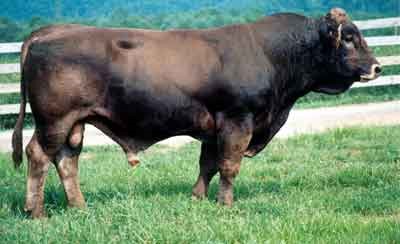 Braunvieh means "brown cattle" in German. Brown
cattle found in the mountains of Switzerland during the 17th century formed the
basis for the modern Braunvieh. They are gaining recognition as a breed for
moderate frame, calving ease, and excellent disposition, efficiency in the
pasture and in the feed yard.
Braunvieh means "brown cattle" in German. Brown
cattle found in the mountains of Switzerland during the 17th century formed the
basis for the modern Braunvieh. They are gaining recognition as a breed for
moderate frame, calving ease, and excellent disposition, efficiency in the
pasture and in the feed yard.Braunvieh are various shades of brown ranging from light brown with gray to very dark brown. The border of the muzzle is very light, as is the poll, and often a lighter colored dorsal stripe is seen. The udder and inside of the legs and underline also being the lighter shade. Darker, smokier shading is often evident around the shoulders and neck compared to the rest of the body. The switch of the tail is d ... | ||
 | ||
| ||
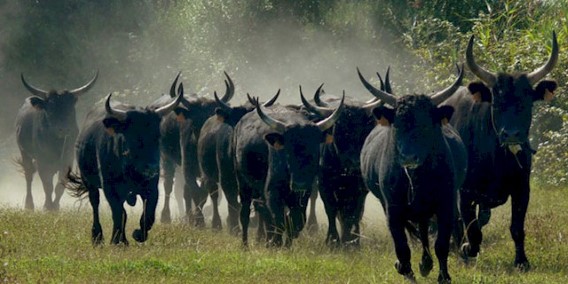 Brava (also known as Espagnole Brava and Race de Combat ) cattle
are principally bred for the bull-ring. But they are also used for meat
production.
Brava (also known as Espagnole Brava and Race de Combat ) cattle
are principally bred for the bull-ring. But they are also used for meat
production.
They were originated from France and raised mainly in the Camargue, the delta of the Rhone in the southern area. Joseph Yonnet first introduced the breeding stock of the Iberian fighting bulls to France in 1869, and there were no further such imports until 1975. A breed society for the Brava was established in 1920, and a herdbook for the breed was established in the year of 1996. The total population of Brava cattle was estimated at 5950 in 2004. But the number were reported to be 3275 in 2014. They are found in Camargue, Provence-Alpes-Côte d’Azur, Petite ... | ||
 | ||
| ||

British White are naturally-polled Cattle related to the
ancient indigenous white cattle of Great Britain known today as White Park
Cattle. They are white with distinctive black (or occasionally red) points –
ears, nose and lower legs. Also sometimes they have color spots in their coat. British White Cattle are historically regarded as a dairy
breed, although some lines were dual-purpose in the past; today they are almost
entirely bred for beef. Source: New Zealand Rare Breeds (www.RareBreeds.co.nz/ ) | ||
 | ||
| ||
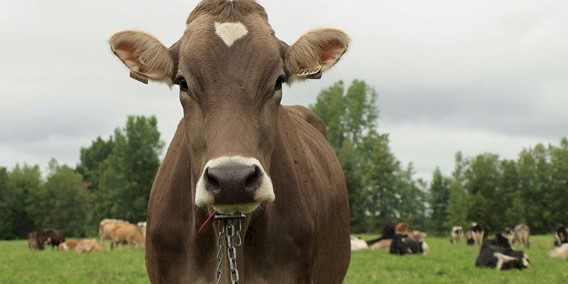 Brown Swiss cattle can be grey, dark brown, tan or even
almost white in color. Their hooves, muzzle and switch are usually black. They
are often noted for their docile temperament.
Brown Swiss cattle can be grey, dark brown, tan or even
almost white in color. Their hooves, muzzle and switch are usually black. They
are often noted for their docile temperament.Perhaps the oldest of all dairy breeds, Brown Swiss originated in the valleys and mountain slopes of Switzerland around 4000 B.C., according to some historians. Today, the beautiful Brown Cattle can still be found across the globe, including in the United States, where the largest concentration is in Wisconsin, Iowa and Ohio. The world population of Brown Swiss is reported to be about 7 million, which ranks either first or second in world-wide population of dairy cattle. The Brown Swiss you see grazing across the United States count ... | ||
 | ||
| ||
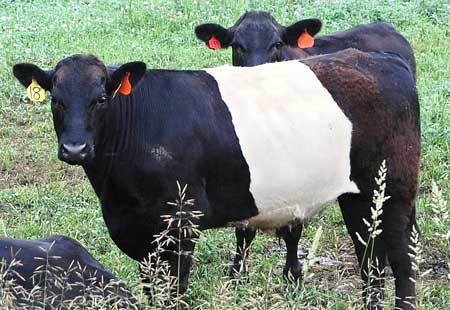 BueLingo cattle were developed by Russ Bueling, a respected
cattle rancher and grain farmer from the Sandhills of South Eastern North
Dakota along with Alfred Ostrum and with the assistance of Russ Danielson,
Professor of Animal Science at North Dakota State University. Mr. Bueling''s
dream about "the ideal beef factory" has become a reality with the
BueLingo breed.
BueLingo cattle were developed by Russ Bueling, a respected
cattle rancher and grain farmer from the Sandhills of South Eastern North
Dakota along with Alfred Ostrum and with the assistance of Russ Danielson,
Professor of Animal Science at North Dakota State University. Mr. Bueling''s
dream about "the ideal beef factory" has become a reality with the
BueLingo breed.
BueLingo cattle are a composite breed. The distinctive belt is largely derived from the Dutch Belt dairy cattle infused with genetics from Scotch Highland, Belted Galloway, Angus, Chianina, Limousin, and Shorthorn cattle. BueLingo cattle have a striking appearance with a white belt and black or cherry red forequarters and hindquarters. ... | ||
 | ||
| ||
 The Burlina comes from
the Venetian Prealpi at the sides of Mount Grappa.
The Burlina comes from
the Venetian Prealpi at the sides of Mount Grappa.It seems it dates back to the Roman times when the Cimbri Migrations led some northern European pied cattle breeds to these regions. The Cimbri belonged to populations living in the Jutland peninsula (Denmark). As a pure breed there still exist very few examples in the provinces of Treviso, Vicenza and Verona nowadays, while in 1930 the stock was of about 15000 heads. The Burlina breed was officially accepted at the first Register office in 1980. Since 1985 the Registry Office of autochthonous cattle breeds and ethnic groups of limited diffusion has been founded, in order to protect those Italian cattle breeds at risk of extinction ... | ||
 | ||
| ||
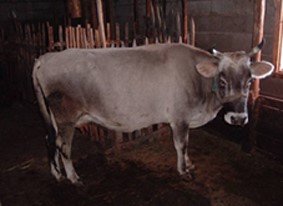 Busa (also known as Busha, Bosnian, or Illyrian) cattle are
a small breed of cattle that belong to the shorthorn cattle group. They are found
throughout southern parts of former Yugoslavia (Dinaric Alps), Bosnia, Croatia,
Macedonia and Serbia. Some sources state that the breed has existed around the
Balkan Peninsula since Neolithic times. Busa cattle from Croatia and Bosnia
were crossed with an Austrian breed in the 19th Century. And this cross is
larger than the original Busa and it is exclusively grey. The Yugoslav army
brought Busa cattle from Serbia during the civil war in the 1990s, and those
animals were all used for meat supply. Currently the Busa cattle and their
cross breeds are widespread over the former Yugoslavia. They
...
Busa (also known as Busha, Bosnian, or Illyrian) cattle are
a small breed of cattle that belong to the shorthorn cattle group. They are found
throughout southern parts of former Yugoslavia (Dinaric Alps), Bosnia, Croatia,
Macedonia and Serbia. Some sources state that the breed has existed around the
Balkan Peninsula since Neolithic times. Busa cattle from Croatia and Bosnia
were crossed with an Austrian breed in the 19th Century. And this cross is
larger than the original Busa and it is exclusively grey. The Yugoslav army
brought Busa cattle from Serbia during the civil war in the 1990s, and those
animals were all used for meat supply. Currently the Busa cattle and their
cross breeds are widespread over the former Yugoslavia. They
...
| ||
 | ||
| ||
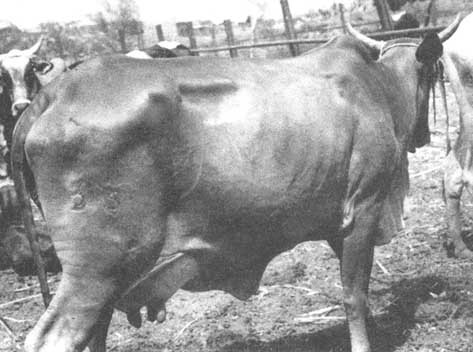 Butana and Kenana breeds are part of the short-horned Zebu group of breeds of eastern Africa. What makes them unusual is that they are dairy breeds, unlike other breeds like the Boran, Baggara, Fung, etc. The Butana breed is found to the east of Khartoum in central Sudan, in the Butana region. The Atbarah Research Station of the Sudanese Department of Agriculture in Atbarah has a special mission for preserving and improving the Butana breed. The Kenana breed is found just south of Butana, mainly in the region between the Blue Nile and the White Nile.
Butana and Kenana breeds are part of the short-horned Zebu group of breeds of eastern Africa. What makes them unusual is that they are dairy breeds, unlike other breeds like the Boran, Baggara, Fung, etc. The Butana breed is found to the east of Khartoum in central Sudan, in the Butana region. The Atbarah Research Station of the Sudanese Department of Agriculture in Atbarah has a special mission for preserving and improving the Butana breed. The Kenana breed is found just south of Butana, mainly in the region between the Blue Nile and the White Nile.
The Butana cattle are a deep red color, like the Red Sindhi and Sahiwal of India. While somewhat smaller than the Sahiwal, the Butana is almost impossible to distinguish from the Red ... | ||
 |